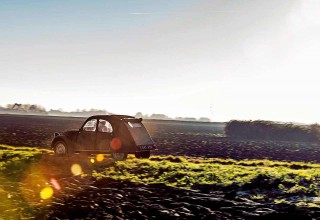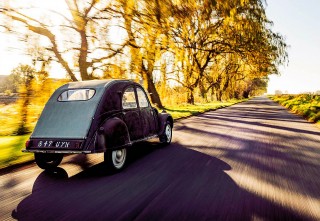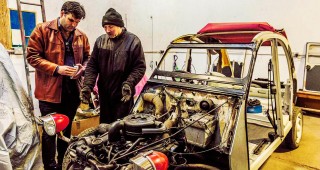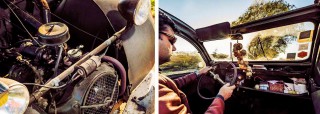The Pilgrimage Citroën 2CV4 road trip across the Picardy-like Lincolnshire fens to meet a marque specialist on a mission to help keep les Deux Chevaux on the road. Citroën 2CV flat-out (at 35mph) on the flat fens of Lincolnshire.
‘Our journey takes us to a tiny piece of rural France in England’s breadbasket’
As far as automotive history is concerned the roads to the west of Bourne, in the flattest part of Lincolnshire, are perhaps the least appropriate place to drive a Citroën 2CV4. Bourne’s automotive legacy is focused on that most power-crazed of racing marques, BRM. With no real test track other than the rutted roads of his farmyard base, BRM patriarch Raymond Mays sent his prewar ERA GP cars out on these straight, quiet fenland roads. The car I’m driving today can’t even muster enough velocity to trigger most speed cameras. But that doesn’t matter, because I’m en route to the Bourne Citroën Centre, a tiny piece of rural France in England’s breadbasket where Barry Annells and his son Peter maintain and restore flat-twin and hydropneumatic Citroëns alike.

The most modest journeys start to feel like daunting adventures when there’s a Citroën 2CV involved. Every aspect of its design is alien in comparison to the car industry’s design consensus. An air-cooled flat-twin of just 425cc drives front wheels so skinny they would look at home on a child’s tricycle. The styling appears to be a Scrapheap Challenge approximation of post-vintage design. The hunchbacked saloon body with separate flowing wings, bonnet and headlights anchor the 2CV’s visual origins in the Forties, but it’s executed using either completely flat or corrugated surfaces, giving the impression that it’s made out of recycled farmyard materials.
I climb aboard the 2CV in the centre of Spalding, a town on the River Welland whose architecture places its heyday in the 18th century, and which makes the river and a series of elegant bridges a focal point in the manner of so many rural French centres. Unfasten the tiny latch with its semi-exposed, minimal mechanism, swing open the tin-thin suicide door, sink into the driver’s seat backsidefirst, and feel the 2CV spring its first surprise of the day as it rolls heavily over on one side, then self-levels on the rebound. All the while it’s as comfortably damped as a well-used mattress, a sense emphasised by seats that look like partially folded camp-beds. The dashboard is almost comically minimal. There’s only one integrated dial – an ammeter, unexpectedly – and two knobs, one to start the engine, the other to switch on the headlights. The speedo looks aftermarket – clamped as it is to the windscreen surround on a snaking cable, its dial’s position requiring a craned neck to read it properly. This is a reminder that in the idiosyncratic world of the 2CV, speed is thoroughly unimportant.

Around-town convenience is much higher on the agenda. Pull the starter knob and the engine whirrs enthusiastically into life in the manner of a petrol lawnmower. An air-cooled flat-twin is unusual outside of the motorcycle world – the TPV 2CV prototypes were built around BMW motorbike engines seized from retreating German forces during World War Two, after all – but amid the agriculturalism there’s sophistication unheard of even in today’s superminis.
It’s got a centrifugal clutch. Originally a key part of the 2CV’s design, it dropped into optional-extra obscurity in 1961, was phased out altogether in 1970 and made a fleeting reappearance only on the 2CV6 Special E of 1981. But once you use one it’s hard to fathom not only why it wasn’t kept as standard, but also why it didn’t catch on more widely. As with any other manual car you push the clutch pedal to disconnect drive from the flywheel when changing gear, but it won’t stall if you take your foot off the pedal with a gear engaged.
This eliminates the need for clutch control and the risk of riding the pedal, and proves to be a boon as I potter through Spalding town centre. With all the speed control I need concentrated on the accelerator, the 2CV can be driven like an automatic in stop-start urban traffic. And yet it remains a manual car, its four gears selected via an angled lever whose shift pattern flows directly from one ratio to another in a sequential path transcribed in a dashboard diagram reminiscent of Harry Beck’s London Underground map.
Turning on to Winsover Road towards the village of Pode Hole, traffic picks up speed and I finally engage the 2CV’s ‘overdrive’ fourth gear – after all, I’ve reached a heady 30mph and the flat-twin is straining. Top speed of the 425cc car is reportedly 42mph, but the 2CV4 seems most comfortable and unstressed wafting along at 35. You’d need a 1971-90 2CV6 to reach 71mph.
And waft it does. Perhaps the most surprising thing about the 2CV is the way its design, while appearing superficially crude, manages to excel in ways that rivals would sacrifice in the name of simplicity. The long, loping travel of the suspension arms creates a gently undulating ride that sands the sharp edges off potholes, the linked springs adjusting the rear suspension in anticipation of the bump the front has just negotiated. Many modern superminis would be fired into surrounding ditches by the harshness of their own damping if you were to tackle these roads at speed. The 2CV, on the other hand, displays excellent roadholding that defies the modern logic of fat, grippy tyres. Even when the camber of the road gets so extreme past Iron Bar Drove that the car feels like it’s leaning at a 45-degree angle, there’s no threat of sliding off the edge because that cleverly adaptable suspension deals with all the punishment these bumpy lanes can deliver.

It’s a stark reminder of the world the 2CV was born into. Although a 40mph top speed may seem inadequate in the context of today’s motoring – where the reality of the motorway means the average hatchback has to possess the unruffled cruising abilities of a Seventies GT – the 2CV was designed to mobilise a country where rural and urban rarely met. The clutch was ideal for traffic-clogged Paris, and the 2CV’s limited top speed didn’t matter too much there either; yet it also suited a country where most of the population worked in agriculture. In rural communities with few metalled roads where much more than 30mph would be risky, ride quality was the key to avoiding breaking eggs and upsetting chickens, and if you needed to get from your village to a city you’d take the train anyway. To this end, a drive in this part of Lincolnshire gifts the 2CV with the opportunity to demonstrate its qualities far better than those smooth, N-road-connected rural areas of France would nowadays.
Another factor in the Citroën’s favour is its sheer simplicity. Chances are the average 2CV owner lived a long way from the nearest Citroën main dealer, but being used to working on tractors he wouldn’t have had any qualms about fixing the car himself.
I like the way the windscreen wipers work. It’s not actually raining as the car bounces over the humpback bridge spanning the River Glen at Tongue End, yet I can’t help but try them out. Pulling a knob meshes the wiper mechanism with the spinning speedo cable. They may not clear the screen very effectively, but the ingenuity of Citroën’s engineers – and their commitment to utter design simplicity while leaving no essentials out – is admirable.

As I near the old BRM garages towards the end of South Fen Road I can’t help but draw an unusual comparison between Pierre Boulanger, the engineer behind the 2CV, and Colin Chapman. Their cars couldn’t be more different in their intentions, but their design approach – of making single components do multiple jobs and minimising unnecessary weight and complexity while doing so – was very similar. I can imagine Chapman admiring the speedometer-driven wipers, the roof fabric doubling as a bootlid, the way all panels can be removed, how the car can be started with the wheelbrace, and the way that just two spring units control all four wheels. He definitely wouldn’t have liked the brakes, though. ‘Feeble’ is the word, and their ineffectiveness encourages a very responsible vigilance, my eyes fixed permanently on the road’s vanishing point. I’m lucky it’s so straight and clear around here, because an emergency stop would be impossible.
I turn right on to Cherry Holt Road, and although I’m not far from Bourne Citroën Centre now, emerging on to a relatively fast-flowing road is something of a rude awakening for the 2CV. After many miles spent blissfully isolated with my right foot squashing the accelerator pedal flat, safe in the knowledge that the gasket-free 12bhp engine will neither overheat nor get me into trouble, I’m surrounded by large, fast modern cars. Even when driving flat-out I’m holding them up like a teenage Valentino Rossi wannabe on a 50cc moped.
And yet I sense goodwill. That’s the lovely thing about the Citroën 2CV. It’s impossible to hate. And this early example – with its Toulouse-Lautrec-style painted numberplate, linseed-oiled panels for homemade rustproofing and yellow headlight lenses – is a charming piece of rustic France that no one expects to see battling for supremacy with HGVs on Bourne’s Périphérique. But I’m not disrupting things for long – a row of Citroëns in varying stages of rebuild coming up on my right tells me we’re nearing journey’s end.

Air-cooled 495cc flat-twin makes a modest 12bhp. Sam used fresh garlic as travel sweets. ‘The 2CV’s gently undulating ride sands the sharp edges off potholes’ Old warehouse stores projects-in-waiting. Right-hand-drive Ami 6 is one of two in the UK. Traction Avant one of several awaiting hard-to-source parts. Barry Annells shows Sam the 2CV most intimate idiosyncrasies.
Pulling into Barry Annells’ premises, I find the Bourne Citroën Centre in a state of transition. Although the Victorian warehouse building on the banks of the appropriately named Bourne Eau is still full of flat-twin projects in varying states of completion – plus the 2CV grasstrack racer Annells used to win the 1982 2CV Cross Championship – the business has expanded into a large workshop across the yard. Annells and his staff are still in the process of deciding where to store the classic Citroën parts amassed during countless raids on autojumbles.
Everywhere I look are Citroëns in states of mechanical undress, from Traction-Avants – a favourite of Barry’s – to the DSuper belonging to Practical Classics magazine’s James Walshe. ‘The 2CV and even the DS are designed so that the engines can be removed without too much bother, so things like changing clutches are straightforward,’ says Barry.
‘From our perspective, they were almost designed to be restored, but progress is all dependent on particular parts. We’re trying to source a flywheel for the blue Bijou in the warehouse, and then there are the Tractions – one’s waiting on a clutch, another on an engine, and we’ve just received one from another garage that they couldn’t complete. We have a reputation for taking on projects that others can’t finish – at the moment we have 12 on the go.’
He gestures to the rack of body and trim parts that dominates the new premises. ‘I just can’t stop finding bits – it’s a disease. Then again, I’ve watched those American TV programmes on storagehunters and hoarders so it’s good to know that I’m not alone!
‘Citroën restoration has changed a lot over the past 10-20 years. Cars that were considered throwaway in the Nineties are now worth restoring. For example, this Ami 6 is one of only two right-handdrive cars in the country, but the previous owner didn’t know how significant it was. Some parts have been remanufactured but you do have to hunt – we found the rear underfloor panels in Holland.’
It’s good to know that he’s upholding the old Citroën ethos of always repairing and never giving up – it’s behind most ingenious aspects of the 2CV’s design after all, and bodes well for the future. And speaking of that future, Barry’s son Peter is equally skilled and enthusiastic, poised to take over the business once Barry eventually calls it a day. And he has an interesting prediction to make.
‘The BX will be the next Citroën to attract attention,’ says Peter, gesturing to one he’s treating to a ground-up restoration, unthinkable a mere five years ago. ‘More people are wanting them, and they do have issues with rusty floors. However, the BX is the last Citroën to combine DS-style suspension and idiosyncratic design with electrical simplicity and ease of maintenance. There’s more enthusiasm for them now than when they were new.’
You heard it here first.
TECHNICAL DATA FILE 1958 Citroën 2CV4
Engine 425cc horizontally opposed two-cylinder ohv, Solex 26 CBI carburettor
Power and torque 12bhp @ 3500rpm; 22.4lb ft @ 2800rpm
Transmission Four-speed manual, front-wheel drive
Brakes Hydraulic drums front and rear, inboard front
Suspension Front: independent, leading arms, pushrods, horizontal helical springs, friction dampers. Rear: independent, trailing arms, pushrods, horizontal helical springs, friction dampers
Steering Rack and pinion
Weight 711kg (1568lb)
Performance Top speed: 42mph; 0-60mph: n/a
Fuel consumption 50mpg
Cost new £598
Values now £3500-£10,000
The Guru – Barry Annells
Citroëns have been part of Bourne Citroën Centre managing director Barry Annells’ life for 60 years. He grew up in a family that bought them almost exclusively, and worked on them since leaving school, taking up an apprenticeship at a main dealer in Kingston-upon-Thames. He helped to introduce 2CV grasstrack racing into the UK in 1976, and won the 2CV Cross Championship in 1982. Annells used to run Shalford Green Garage in Guildford, Surrey, but since 1999 he’s focused his business full-time on the repair, restoration and servicing of classic Citroëns and related Peugeots in Lincolnshire. He and his team make regular visits to France and Holland with shopping lists of rare items compiled during the stripdown stage of each restoration.

OUR TEST ROUTE
Once out of Spalding, our meandering route follows a complex of raised banks, drainage ditches and seemingly endless ploughed fields west of Pode Hole. It’s all reminiscent of the rural areas of France for which the 2CV was built. It doesn’t feel like a long drive in a modern car, but in something with a 35mph cruising speed and tinny bodywork, it can feel intimidating. Bumpy roads test the suspension, and Tongue End’s blind bends and humpback bridges threaten a need for an emergency stop – hardly the 2CV’s forte…





